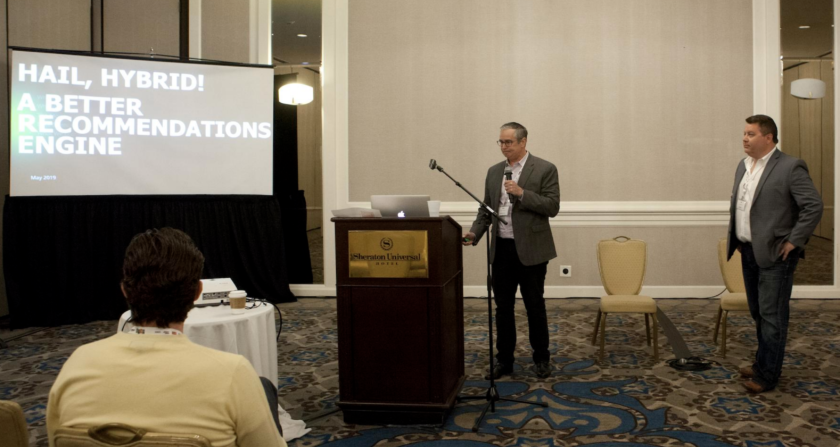HITS

HITS Spring: SoftServe Looks to a Better Recommendation Engine
Story Highlights
There is more content than ever out there and it’s enormously challenging for broadcasters to get viewers to watch their content and keep them engaged, so it’s crucial to create a “competitive advantage,” according to Matt Kollmorgen, VP of digital strategy at Austin, Texas-based SoftServe.
SoftServe’s Recommendation Engine 2.0 can provide that competitive edge, he said May 23, during a breakout session called “Hail, Hybrid: A Better Recommendation Engine” at the annual HITS Spring event during which he explained why his company created the engine and how it can help broadcasters.
SoftServe leveraged more than 25 years of big data, artificial learning (AI) and machine learning (ML), and human-centric design expertise to create the hybrid engine that features O.C.E.A.N. personality integration, works on any platform, and integrates with both new and existing engines, according to the company.
Media companies that are focused on creating digital viewing experiences are standing at a fork in the road now regarding recommendation engines. These engines are a critical component of any user experience—increasing engagement, usage, and time spent with brand. Frontrunners in the space have put a lot of thought and care into creating their engines, and are benefiting from the results. But most recommendation engines fall short, as does their value to the customer and the brand, Kollmorgen argued.
“We’ve been around for almost 26 years” and now have a staff of about 8,000 people globally, he noted at the start of the presentation. “Historically, we’ve been kind of the guys behind the guys … . If you’ve looked at the weather on your phone, if you’re read a review of a product on Bestbuy.com … you’ve touched software that we have built,” he told attendees.
SoftServe is focused on solving problems in four media areas, he pointed out: The video content supply chain, data analytics, cloud-based workflows and DevOps/automation.
The company, a while back, “embarked on [a] journey” to figure out how to satisfy clients that wanted to “deliver more personalized experience to their audiences,” he said, noting “our challenge was we didn’t really like the data we were seeing,” which pretty much came in “four buckets.” First, there was content data, but it wasn’t being leveraged properly, only offering lots of video IDs, he said. Second, there was much better player data, including user IDs and info on the quality of a stream, if people were viewing ads and if they continued watching after seeing the ads, he noted, adding: “There was a lot that we could glean from the player data.”
There was also geographic data, but that was only when such info was provided, and then there was conversion data, which identified who was looking at what content and whether they actually played it, he said.
A major “challenge” was that most of the data gave only a “very general overview” of users and was not really user-based at all really – rather, it was more content-based, he pointed out.
So, SoftServe “set out to do something different,” he said. After all, as viewers, “we all want personal experiences — we all want custom, tailored content delivered to us, so we don’t have to hunt around because frankly we don’t have the time; there’s just too much out there for us to watch,” he said.
Viewers have typically been treated as groups, not as individuals, so “we wanted to create an engine that would recommend content based on their interests, based on their lifestyle — not just what they watched in the past or what the network or broadcaster wanted them to watch in the future,” he told attendees.
SoftServe started looking at data sources and realized it “could leverage trends [and] we could get access to social graphs, past consumption habits — even on other platforms,” and also see what kinds of devices viewers were using, their retail purchases, where they’re shopping and other information, he said.
In all, there was just a “plethora of personal data that we could start to leverage,” he said. So, SoftServe worked with broadcasters to figure out how they could use a recommendation engine to best keep viewers on a platform by keeping them engaged and coming back, he said.
Chip Plesnarski, media solutions lead-media advisory at SoftServe, went on to explain how “everything sort of works under the hood” of Recommendation Engine 2.0. Its main components are an unlimited mixture of recommenders that are content-based, collaborative-based and hybrid; a user profile that includes user feedback and user interaction; and global probabilistic electors, according to the company.
Of that latter ingredient, Plesnarski said “we’re using the Thompson sampling method,” which is a mathematical algorithm designed to “explore and exploit. It uses a “self-teaching machine learning process and it instantly self-corrects” also, he said.
With its hybrid approach, the engine can evaluate an unlimited number of data sources used in the recommenders – ML algorithms that compare data sets, user actions, social activity, retail data and more, according to the company. All of these various recommenders are processed and sent to the engine’s Recommendation Learning Agent to use probability sampling algorithms in order to find the most likely matches, according to the company. As that process is repeated over time, the data and machine “knowledge” becomes even more accurate and rewarding, SoftServe says.
HITS Spring was presented by Entertainment Partners, with sponsorship by LiveTiles, 5th Kind, Amazon Web Services, Birlasoft, Exactuals, Expert System, MarkLogic, Microsoft Azure, Richey May Technology Solutions, SoftServe, Spark Digital, Avanade, CDSA, Cinelytic, EIDR, MicroStrategy, Signiant, the Trusted Partner Network, human-I-T, and Zaszou IT Consulting.
The event was produced by the Media & Entertainment Services Alliance (MESA) and the Hollywood IT Society (HITS), in association with Women in Technology: Hollywood (WiTH); the Content Delivery & Security Association (CDSA); and the Smart Content Council.
Click here to download audio of the SoftServe presentation. Click here to download the slide deck.









